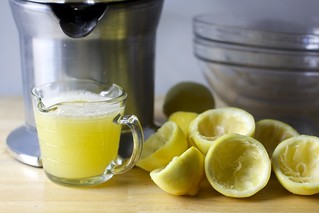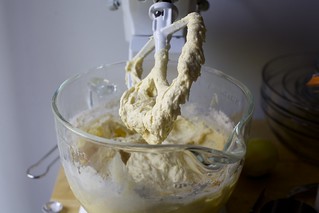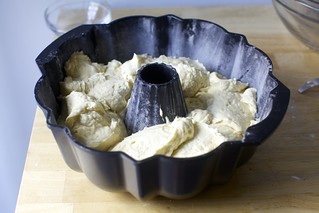lemon pound cake
I have this theory, or shall we call it a personality disposition, that nothing is ever really perfect. While I would argue this pickiness is unfortunate outside the kitchen — “This date would have been even more perfect if I’d ordered the eggplant and not the chicken.” “I love my haircut except this completely unnoticeable thing going on in the back.” — within the confines of the galley walls, I think nit-picking, when done quietly, helps us become better cooks.
Though a big fan of the small nuances that remind you that home cooked food is precisely that — tart crusts with the inevitable corner pieced together from a scrap, a dark spot on loaf of bread that wasn’t rotated in the oven in time — I find it nearly impossible to eat something I’ve made without making a mental note of how I’d do it differently next time. More hot pepper. Less baking time. Ease up on the olive oil. Blanche the peppers for thirty seconds less.
Which kind of brings us to the lemon pound cake (made here in bundt form) from Ina Garten, a name I’m almost embarrassed to mention I am using as a source once again, as I know I said just a couple weeks ago that we should spend some time apart. I can’t resist this cake though, I think it’s one of the ten great cakes every cook should have tucked into their repertoire. It’s buttery yet bright, and nearly every granule of sugar has been countered by fresh lemon in some form so it never lands cloying or saccharine on your tongue. It keeps well, travels wells and if you make it in pound cake form, you even have an extra that you should feel in no way obliged to share.
So Debbie Downer, what went wrong this time? Well, the lemon syrup that in basting the warm cake with, raises it to that higher plane of moisture-packed crumb, it wouldn’t absorb! When the large spoonfuls rolled down the sides and pooled at the bottom, I made them smaller and smaller until I could find an amount the cake would agree to absorb – but one or two droplets at time. I suspect this is something like feeding a child, where you beg and plead for the thing to just take in two bites and we’ll call it a day. But, as no child’s well-being rested on the absorption of syrup, when fatigue called twenty minutes into this expedition, I simply dumped the remaining liquid over the cake, absorption be damned as it flooded the plate underneath, gumming it nearly permanently to rack underneath, which is by the way the second thing I would do differently next time: not let the cake cement itself to its base, so that when it needs to be transferred to a cake carrier, it loses small chunks and the otherwise flawless white glaze becomes cracked.
I remember having this problem the last time I made the cake, but it was less significant in the pound cake form, with its more level top surface. Yet this time, I could taste the lack of extra moisture. Without that basting, this cake is wonderful, but a lot more like the simple pound cake it’s based on. Not sure how I’ll do it differently next time — would a lemon syrup-filled syringe be considered a step too far? — but without a doubt, I will be musing over this for a while. Let me know if you’ve tried this, and found anything that worked better. My unrelenting inner persnicketer is dying to know.
Lemon Pound Cake
New 2019 notes: I have been making this cake for well over a decade and still consider it the height of lemon pound cake achievement; it’s perfect for host gifts, brunches, summer picnics, and more. But I’m a bit lazier these days and try to one-bowl the recipe, while enhancing the flavor along the way. I don’t want to change the recipe below for those who are loyal to the original, but should be you be interested in saving a little time or dirty dishes, six Smitten Kitchen-ified tips have been added at the end.- 1 cup (225 grams or 8 ounces) unsalted butter, at room temperature
- 2 1/2 cups (500 grams) sugar
- 4 extra-large eggs, at room temperature
- 1/3 cup grated lemon zest (6 to 8 large lemons)
- 3 cups (390 grams) all-purpose flour
- 1/2 teaspoon baking powder
- 1/2 teaspoon baking soda
- 1 teaspoon (5 grams) kosher salt
- 3/4 cup (175 ml) plus 3 1/2 tablespoons (50 ml) freshly squeezed lemon juice
- 3/4 cup (175 ml) buttermilk, at room temperature
- 1 teaspoon (5 ml) vanilla extract
- 2 cups (240 grams) powdered sugar, sifted if lumpy
Heat oven to 350 degrees F (175 degrees C). Grease and flour two 8 1/2- by 4 1/4-inch loaf pan, and line the bottoms with parchment paper. Alternatively, you can generously butter and flour a bundt pan. [Shown here is a 12-cup bundt. I haven’t tested it in a 10-cup bundt but it does look like there is room to spare in the 12-cup.]
Cream butter and 2 cups (400 grams) of the sugar (leave the last 1/2 cup for the syrup) in the bowl of an electric mixer fitted with a paddle attachment for about 5 minutes, or until light and fluffy. Mixing at medium speed, add eggs, one at a time, and lemon zest.
Sift together flour, baking powder, baking soda and salt in a bowl. In another bowl, combine 1/4 cup (60 ml) lemon juice, buttermilk and vanilla. Add flour and buttermilk mixtures alternately to butter and sugar mixture, beginning and ending with flour. Divide batter evenly between loaf pans or pour into prepared bundt, smooth top(s), and bake for 45 minutes to 1 hour, until a cake tester comes out clean. The bundt version tends to be done in 45 to 50 minutes.
Make soaking syrup: Combine remaining 1/2 cup sugar with 1/2 cup lemon juice in a small saucepan, and cook over low heat until sugar dissolves.
When cakes are done, let them cool 10 minutes. Invert them onto a rack set over a tray, and spoon lemon syrup over cakes. Let cakes cool completely.
Make the glaze: Combine confectioners’ sugar and remaining 3 1/2 tablespoons lemon juice in a bowl, mixing with a whisk until smooth. Pour over top of cakes, and allow glaze to drizzle down the sides.
Six additional tips and shortcuts, added in 2019:
[Note: This recipe got fresh photos in 2019.]
Share this:
Related
ncG1vNJzZmirnZ7BtbHNpKCtm5iau2%2BvzqZma2hga3xyfI6lnKannmK9sMHNnWScmZuafA%3D%3D









